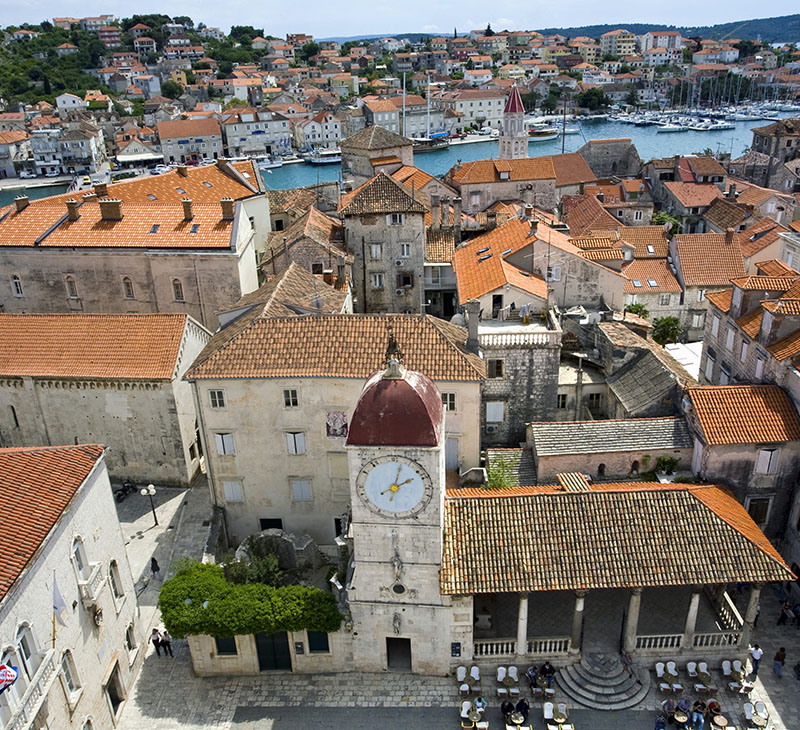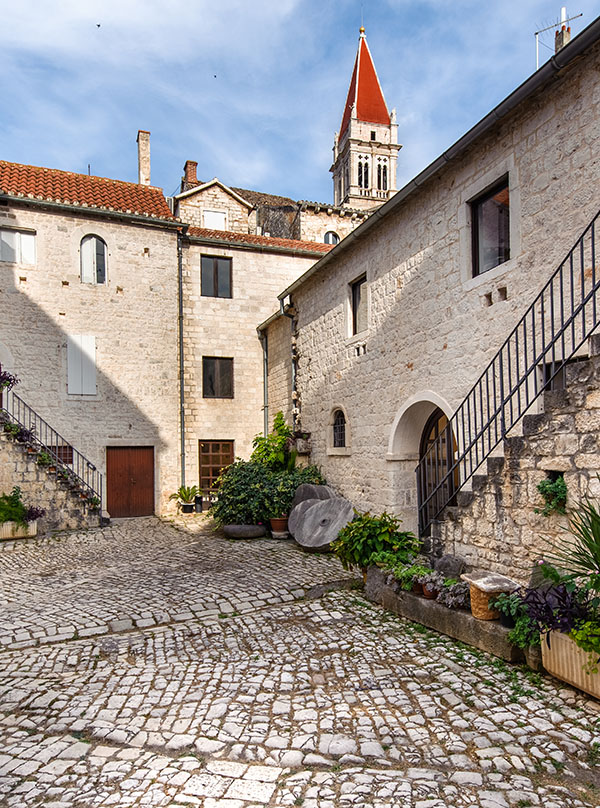
Trogir
The town-museum…
Trogir (Latin: Tragurium; Ancient Greek: Τραγύριον, Tragyrion or Τραγούριον, Tragourion, Trogkir; Italian: Traù; Hungarian: Trau) is a historic town and harbour on the Adriatic coast in Dalmatia. The historic city of Trogir is situated on a small island between the Croatian mainland and the island of Čiovo. It lies 27 kilometres (17 miles) west of the city of Split. Since 1997, the historic center of Trogir has been included in the UNESCO list of World Heritage
The old center on the small island, inscribed in 1997 on the UNESCO World Heritage List, developed between the 13th and 15th century within the city walls and was reconstructed by Venice in the 15th century.
Two of the buildings from the same century, which have survived up to now, are Kamerlengo Citadel and St. Mark’s Tower. The older, eastern part of the town spread out around the main square with the Cathedral. The western part, Pasika, developed later. A new settlement on the island of Ciovo dates back to the period of the wars with the Turks.
The city walls were destroyed at the beginning of the 19th century. Trogir used to be one of the most significant cultural centres of Dalmatia. Master Radovan (13th century), 15th-century sculptors and builders Ivan Budislavljic, Matej Gojkovic, Nikola Firentinac (Nicholas of Florence), Andrija Alesi, Ivan Duknovic (Trogir-born) and Blaz Jurjev Trogiranin, 15th- and 16th-century humanists Petar and Koriolan Cipiko as well as Fran Trankvil Andreis, a friend of Erasmus of Rotterdam, and the 17th-century historian Ivan Lucic, all lived and worked in Trogir.
The relief of Kairos - God of Happy Moments- is kept in the Benedictine nunnery in Trogir. Kairos is shown as a naked young man with a tuft of hair - one needs to grab it at the right moment or the chance will be lost forever as Kairos is always in a hurry! ...


The town of the happy moments…
The late Renaissance city gate (17th century) represents the northern entrance into the town. The narrow and picturesque alleys with several beautiful palaces (the Baroque Garanjin-Fanfogna Palace, now the Town Museum collection of stone monuments) lead to the Narodni Trg square, now St. John Paul II square.
The three-nave Cathedral of St. Lawrence (13th – 15th century) is to the north. Through a vestibule you can reach the main gate, the Radovan’s Portal, built by Master Radovan and his co-workers, in 1240.
The Town Loggia from the 15th century is on the southern end of the square; it features two reliefs: The Justice (Nicholas of Florence, 1471) and Viceroy (ban) Berislavic (by I. Mestrovic).
The Town clock tower, once the small Renaissance church of St. Sebastian rises near the Loggia (the statues of Christ and St. Sebastian on the front were probably made by Nicholas of Florence). The three-nave early mediaeval church of St. Barbara (11th century), the oldest church in Trogir preserved in its original form, is situated behind the Loggia.
The complex of the Cipiko Palace, consisting of a big palace – portal (I. Duknovic), and a small palace, separated by an alley, closes the western part of the square. Opposite the Palace is the 15th-century Town Hall, with its Romanesque façade overlooking the square; the Gothic yard comprises coats of arms and a stone head (the legend has it that it represents the sculptor Matej Gojkovic).
The town of the happy moments….
The street running alongside the Town Hall leads to the coast, where the Romanesque church of St. John the Baptist (13th century), with the ruins of mediaeval walls, is situated. The church accommodates the tomb of the Cipiko family, the relief representing The Mourning of Christ (Nicholas of Florence, around 1470); the church has recently established a picture gallery (Pinakoteka) with paintings (14th to 17th century), statues and codices.
The path further down the coast leads to the Renaissance town gate; the Benedictine nunnery (founded in 1064 and extended in the 16th century) with the church of St. Nicholas is to the right. The Renaissance bell tower was erected in 1598. The collection of the monastery keeps the relief depicting Kairos, the Romanesque-style Madonna with Child, a painted Gothic crucifix, etc.
The path goes past the stone pole on which the flag was raised – Standarac (1605) to the Renaissance Lucic Palace (1604), with a nice portal and a courtyard. The street to the right leads to the Renaissance church of St. Peter (Baroque main altar). West of Lucic Palace is the monastery and the church of St. Dominic, a one-nave structure from the 14th century with Baroque altars
The isolated belfry (1595) of the church of St. Michael, destroyed during bombardment in 1944, rises to the northwest of the monastery. The Kamerlengo Citadel, once connected with the city walls, rises in the south-western part of the small island. The high tower of the citadel represents an expansion of the earlier Genoa Tower from 1380. The Castle’s current appearance dates back to the 15th century. North of the Castle is the round tower of St. Mark from the 15th century and the classicist gloriette between the Castle and the tower originates from the period under the French occupation. The town graveyard, 2 km northeast of Trogir, accommodates the relief of Our Lord (Nicholas of Florence).
(source: www.sitiunescoadriatico.org)






